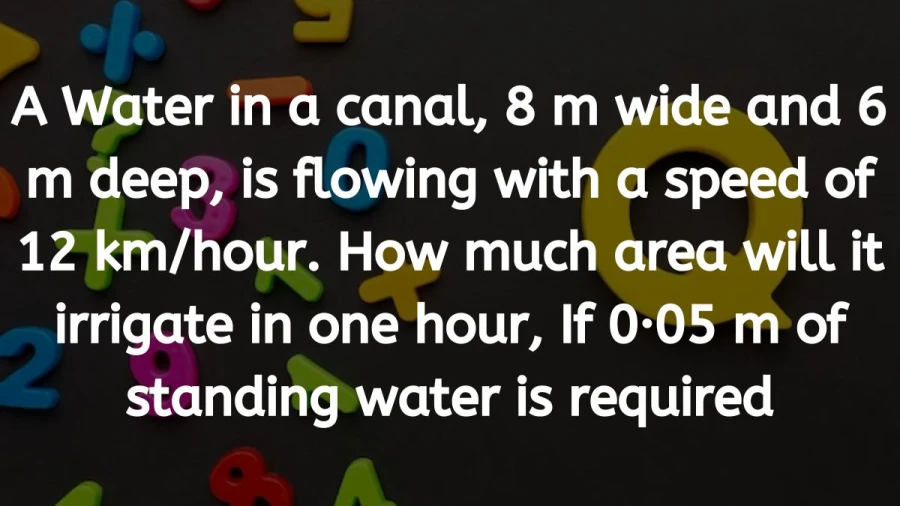If you happen to be viewing the article A Water in a canal, 8 m wide and 6 m deep, is flowing with a speed of 12 km/hour. How much area will it irrigate in one hour, If 0·05 m of standing water is required? ? on the website Math Hello Kitty, there are a couple of convenient ways for you to navigate through the content. You have the option to simply scroll down and leisurely read each section at your own pace. Alternatively, if you’re in a rush or looking for specific information, you can swiftly click on the table of contents provided. This will instantly direct you to the exact section that contains the information you need most urgently.
A Water in a canal, 8 m wide and 6 m deep, is flowing with a speed of 12 km/hour. How much area will it irrigate in one hour, If 0·05 m of standing water is required?
11.52 km² of area will be irrigated in one hour.
Given:
Width of the canal (w) = 8 m
Depth of the canal (d) = 6 m
Speed of water (v) = 12 km/hour
Required height of water for irrigation (h) = 0.05 m
First, let’s calculate the volume of water flowing out in one hour:
Volume of water flown out in 1 hour = Width × Depth × Speed = 8 × 6 × 12,000 m³
Volume of water flown out in 1 hour = 576,000 m³
Since this water will be used to irrigate a certain area, the volume of the irrigated area will be equal to the volume of water flown out in one hour.
Article continues below advertisement
Area × Height = 8 × 6 × 12,000
Given that the height (h) is 0.05 meters:
Area × 0.05 = 8×6×12,000
Area × 0.05 = 576,000
Area = 576,000 / 0.05
Area = 11,520,000 m^2 =11.52 km^2
Area=11,520,000 m^2 = 11.52 km^2
Therefore, 11.52 km² of area will be irrigated in one hour.
Rates and Ratios
Rates and ratios are mathematical concepts used to compare quantities or express relationships between different quantities.
-
Rate: A rate compares two different kinds of quantities measured in different units. It is typically expressed as a ratio of two quantities with different units. For example, miles per hour (mph) is a rate that compares distance (miles) to time (hours).
Example: If you travel 60 miles in 2 hours, the rate of your travel is 60 miles / 2 hours = 30 miles per hour.
-
Ratio: A ratio compares two quantities of the same kind. It shows how many times one quantity is contained within another. Ratios are often expressed in the form of a fraction, using a colon, or as a decimal.
Example: If a bag contains 5 red marbles and 3 blue marbles, the ratio of red marbles to blue marbles is 5:3 or 5/3.
Rates and ratios are fundamental in various fields, including mathematics, finance, science, and everyday life, for comparison, analysis, and decision-making.
Article continues below advertisement
Article continues below advertisement
Thank you so much for taking the time to read the article titled A Water in a canal, 8 m wide and 6 m deep, is flowing with a speed of 12 km/hour. How much area will it irrigate in one hour, If 0·05 m of standing water is required? written by Math Hello Kitty. Your support means a lot to us! We are glad that you found this article useful. If you have any feedback or thoughts, we would love to hear from you. Don’t forget to leave a comment and review on our website to help introduce it to others. Once again, we sincerely appreciate your support and thank you for being a valued reader!
Source: Math Hello Kitty
Categories: Math

